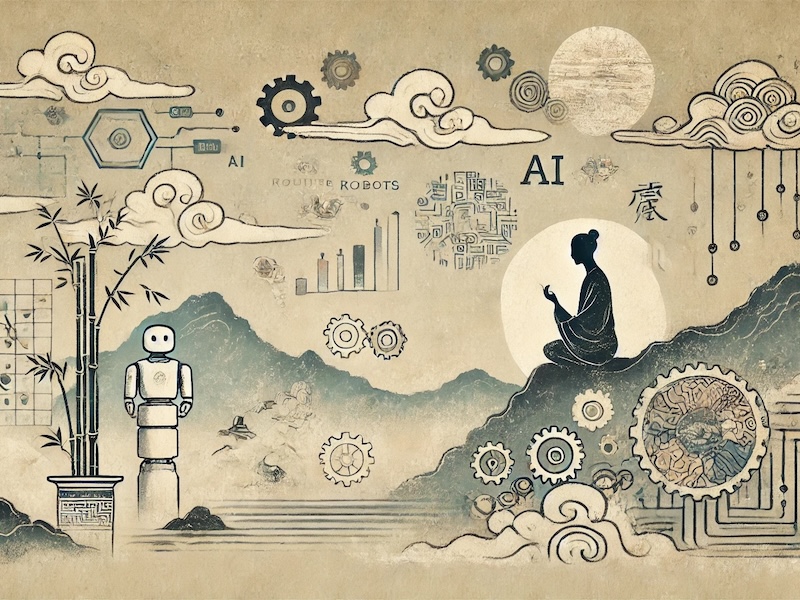artwork by Nano Banana
BMAD V6 Intellectual Ecosystem for Understanding Legacy Software
Applied BMAD
Part 2 of 3When we think about interacting with AI, the image that often comes to mind is a simple conversation: we ask a question, and the AI gives us an answer. We use prompts to generate content, analyze data, or write code. In this model, AI is a powerful but ultimately reactive tool, an oracle waiting for our next query. This approach unlocks a fraction of its potential, especially when facing truly complex, systemic challenges.
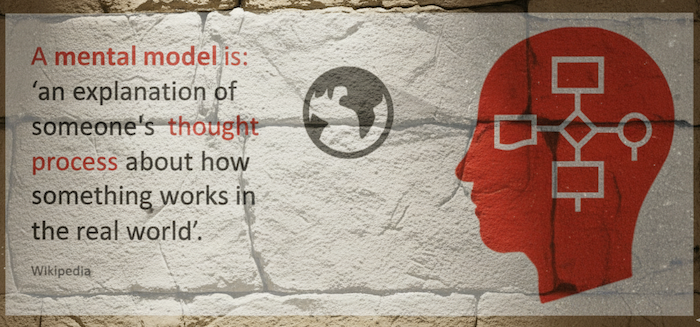 Figure. A mental model is more than a way of thinking — it’s the architecture of understanding itself.
Figure. A mental model is more than a way of thinking — it’s the architecture of understanding itself.
But what if we moved beyond simply prompting an AI? A framework called BMAD-V6 (Breakthrough Method for Agile AI-Driven Development - version 6) presents a more profound perspective. It frames AI not as a tool to be queried, but as a component within a complete intellectual ecosystem. It offers a philosophy of systematic problem-solving, one that redefines how humans and AI can collaborate to deconstruct, understand, and resolve intricate challenges. This article explores five impactful ideas from this philosophy that can change how you think about AI and problem-solving.
Why BMAD-V6 Matters? The BMAD-V6 framework (currently in alpha) represents a major evolution of the BMAD philosophy. Its most significant addition, the BMAD Builder module, enables users to create new modules within the BMAD ecosystem itself. This means we’re no longer limited to static components. With BMAD-V6, we can extend and customize the system dynamically, ensuring that new agents and workflows integrate seamlessly and operate cooperatively as part of a unified, intelligent ecosystem.
1. First, You Must Tame the Chaos
The BMAD V6 framework’s first step is not to ask a question but to perform a rigorous act of definition. It demands a clear Problem Statement, an identification of the problem’s Impact, the articulation of the solution’s Value Propositions, and a deliberate statement of what is “In Scope” and “Out of Scope.” This initial discipline is philosophically critical. It is analogous to the act of naming in science, which transforms a chaotic, amorphous problem, like “our legacy code is a mess” into a bounded, addressable challenge.
This act of definition forces clarity before any action is taken. It asserts that you cannot solve a problem you have not first defined. By creating boundaries, the framework converts an overwhelming and seemingly infinite problem space into a finite territory that can be explored methodically. It creates order from chaos through deliberate definition.
By drawing a line in the sand, it transforms an infinite, overwhelming domain into a finite territory that can be methodically explored.
Once a problem is defined and bounded, the next step is to assemble the right kind of intelligence to explore it.
2. Build a Team of Personas, Not a Monolithic AI
Instead of creating a single, monolithic “helper” AI, this philosophy insists on building a team of specialized AI agents. This is a profound philosophical choice and a radical departure from conventional thinking. It suggests that true expertise is not a generic, singular intelligence but a tapestry of distinct, specialized perspectives. Each agent is a “personified philosophy of practice,” embodying an unique mode of expert thinking.
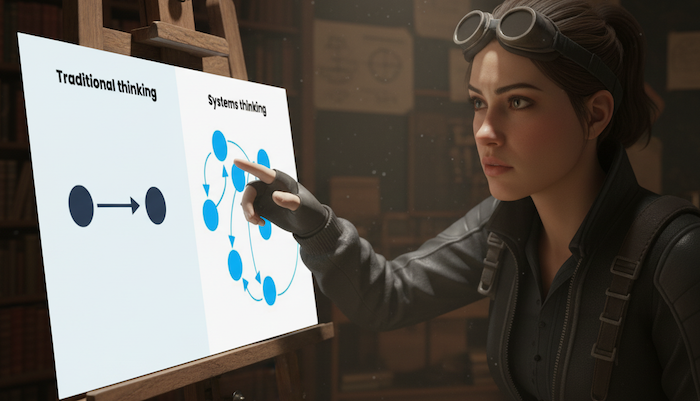 Figure. From Linear Logic to Living Systems: Rethinking AI as an Ecosystem of Experts Instead of building a single, monolithic “helper” AI, this philosophy embraces systems thinking—a shift from linear cause-and-effect reasoning to dynamic networks of interdependent parts. Each AI agent becomes a specialized node in a living system of intelligence, embodying its own philosophy of practice and unique mode of expert reasoning.
Figure. From Linear Logic to Living Systems: Rethinking AI as an Ecosystem of Experts Instead of building a single, monolithic “helper” AI, this philosophy embraces systems thinking—a shift from linear cause-and-effect reasoning to dynamic networks of interdependent parts. Each AI agent becomes a specialized node in a living system of intelligence, embodying its own philosophy of practice and unique mode of expert reasoning.
For example, a team designed to analyze legacy software might include:
- Dr. Ada (the Archaeologist): Embodies the principle of systematic, patient discovery. Her philosophy represents the deep, methodical investigation required to understand the why behind the code, operating under the belief that “Context is everything.”
- Atlas (the Code Cartographer): Embodies the philosophy of visual thinking. Her core principle, “A picture is worth 10,000 lines of code,” asserts that complex relationships can only be truly grasped when they are mapped spatially.
- Morgan (the Documentation Curator): Embodies a user-centric philosophy of clarity. His belief that “Documentation should answer questions before they’re asked” shifts the focus from simple recording to proactive, empathetic knowledge transfer.
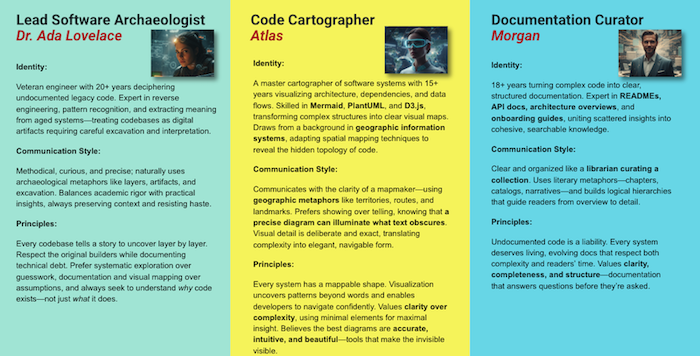 Figure. An illustration of different persona, defining the AI agent identity, communication style and principles that guide the AI mental model of practice and unique mode of expert reasoning.
Figure. An illustration of different persona, defining the AI agent identity, communication style and principles that guide the AI mental model of practice and unique mode of expert reasoning.
The power of this approach lies not just in the individual experts, but in designing the system of interaction between them. By designing agents this way, we codify different professional philosophies and allow them to collaborate.
The solution to the problem emerges not from one agent’s answer, but from the orchestrated dialogue between these distinct, personified forms of expertise.
But a team of brilliant experts is useless without a rigorous process to guide their collaboration. This is where workflows provide the necessary discipline.
3. Enforce a Discipline of Thought
If a team of specialized agents embodies expertise, then workflows are the scaffolding for their rigorous thought. Within the BMAD framework, a workflow is more than a script; it is a structured, repeatable methodology for inquiry, “akin to the scientific method for software analysis.” A workflow guides both the user and the AI agent team along a carefully designed cognitive path, moving sequentially from orientation to deep analysis and finally to synthesis.
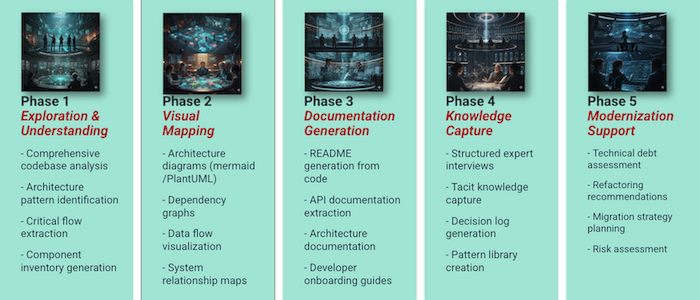 Figure. These workflows don’t just automate tasks—they enforce disciplined thinking, ensuring that analysis unfolds methodically from orientation to synthesis. Like the scientific method for software, they turn expertise into a replicable process of discovery and reflection.
Figure. These workflows don’t just automate tasks—they enforce disciplined thinking, ensuring that analysis unfolds methodically from orientation to synthesis. Like the scientific method for software, they turn expertise into a replicable process of discovery and reflection.
This structured process is powerful because it prevents the “intellectual shortcuts” a human might take under pressure. For instance, a developer might be tempted to jump straight into analyzing a specific function. The workflow, however, can enforce a process that insists on first understanding the broader architectural context, preventing narrow, context-free analysis that often leads to errors. The system isn’t just automating tasks; it’s enforcing a higher-quality, more disciplined cognitive process for both human and AI.
4. Actively Fight Knowledge Entropy
A common crisis in any organization is the problem of “tacit knowledge”, critical information that exists only in the minds of a few senior experts. When those experts leave, the knowledge is lost forever. The BMAD framework is philosophically designed to combat this. Its processes are built to systematically convert this tacit knowledge into explicit, durable artifacts.
The knowledge-extraction workflow is the most direct tool for this conversion, providing a structured framework for interviewing experts to unearth hidden assumptions. The system recognizes that knowledge is not static; it must be actively “excavated,” as the persona of Dr. Ada suggests. Once unearthed, this knowledge is then “crystallized” into structured documents, diagrams, and guides by agents like Morgan, the Documentation Curator. The entire system is designed to fight against the “natural entropy of institutional knowledge,” ensuring that what was once ephemeral becomes a permanent and accessible part of an organization’s memory.
5. Stop Prompting, Start Architecting
Synthesizing the previous points reveals the ultimate takeaway: this philosophy elevates the role of the human user. You are no longer a mere “prompter” asking an AI for answers; you become the “architect of an intelligent system.” Your job is to design the entire problem-solving engine.
As a systems architect, this philosophy compels you to think and act differently, focusing on four key responsibilities:
- Deconstruct a problem into its fundamental principles and boundaries.
- Embody the required expertise into a team of specialized, collaborating agents.
- Structure the problem-solving process into a rigorous, repeatable workflow that guides inquiry.
- Codify the resulting insights into durable, explicit artifacts.
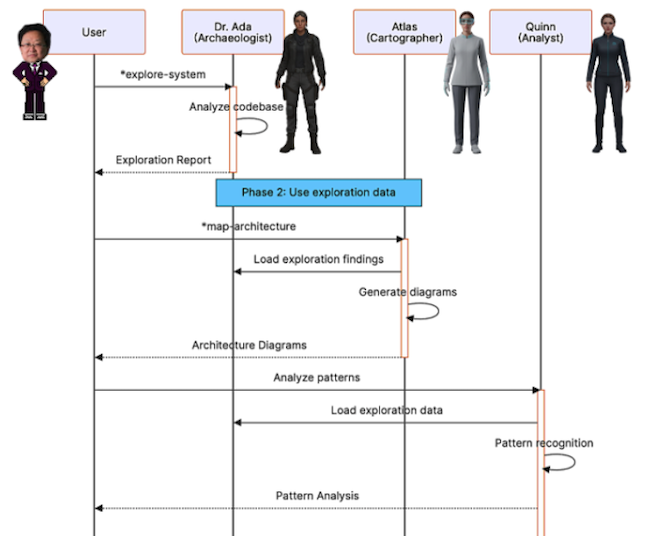
Figure. This diagram illustrates a collaborative cognition workflow, where the human user orchestrates a team of specialized AI agents—each embodying a unique philosophy of expertise. Rather than issuing commands, the user designs the process itself, defining how inquiry unfolds: Ada explores, Atlas maps, Quinn analyzes, and Morgan curates.
This represents a philosophical leap beyond simple AI interaction. Instead of asking an AI to solve a problem, you are building a complete, self-contained intellectual engine designed to master a specific problem domain.
Concluding Remarks
The true potential of artificial intelligence is unlocked not by the sophistication of its answers, but by our ability to design holistic systems that leverage its power. A framework like BMAD-V6 demonstrates that by shifting our perspective, from prompting a tool to architecting an ecosystem, we can augment our own problem-solving. This integrated approach, where defining problems, embodying expertise in agents, structuring their collaboration with workflows, and codifying knowledge all work in concert, elevates our own ability to think.
It challenges us to become more systematic, more disciplined, and more intentional in how we approach complexity. It suggests that the most powerful collaboration between human and machine happens not in the answer, but in the design of the inquiry itself.
What chaotic problem in your own work could be tamed if you first treated it not as a question to be answered, but as a system to be designed?
References
- BMad Code, The BMAD Builder is Here - V6 Alpha: 5 Major Features, video, 6 Oct 2025.
- Revealing 5 game-changing features that will transform how you build AI-powered applications. Get early access to the alpha release and join the 100’s of thousands globally revolutionizing their workflow and how they interact with AI.
- BMad Method - Foundations in Agentic Agile Driven Development, known as the Breakthrough Method of Agile AI-Driven Development
Appendix
Claude Agent Skills
- Anthropic, introduced Claude Skills, Product Blog, 16 Oct 2025.
- Claude can now use Skills to improve how it performs specific tasks. Skills are folders that include instructions, scripts, and resources that Claude can load when needed. Claude will only access a skill when it’s relevant to the task at hand. When used, skills make Claude better at specialized tasks like working with Excel or following your organization’s brand guidelines.
Anthropic’s “Claude Agent Skills” can integrate harmoniously with BMAD agents by providing the concrete mechanism to codify and embody the specialized expertise and rigorous workflows required by the BMAD framework. BMAD is built upon a team of specialized AI agents, where each agent embodies a specific role and a “personified philosophy of practice,” such as an Architect or Developer. Claude’s Skills function as a package of expertise and allow Claude to become a specialist in tasks, for example, working with Excel or following specific organizational guidelines. This specialization aligns directly with the need for BMAD agents to enforce disciplined thinking and rigorous, repeatable methodologies. Furthermore, Skills extend Claude Code with a team’s agents and workflows, allowing for programmatic control over custom skills, supporting BMAD’s core principles of enterprise-grade governance, traceability, and versioned accountability for all project artifacts.

